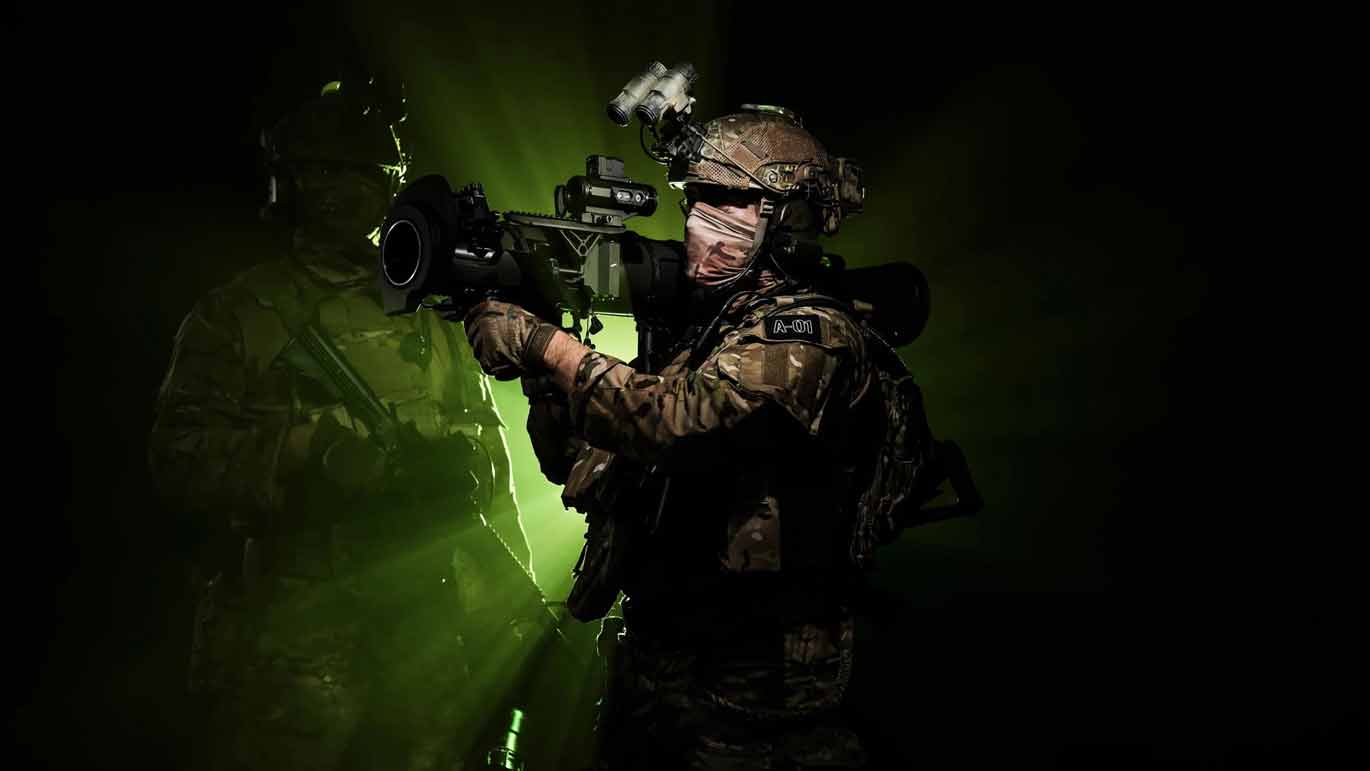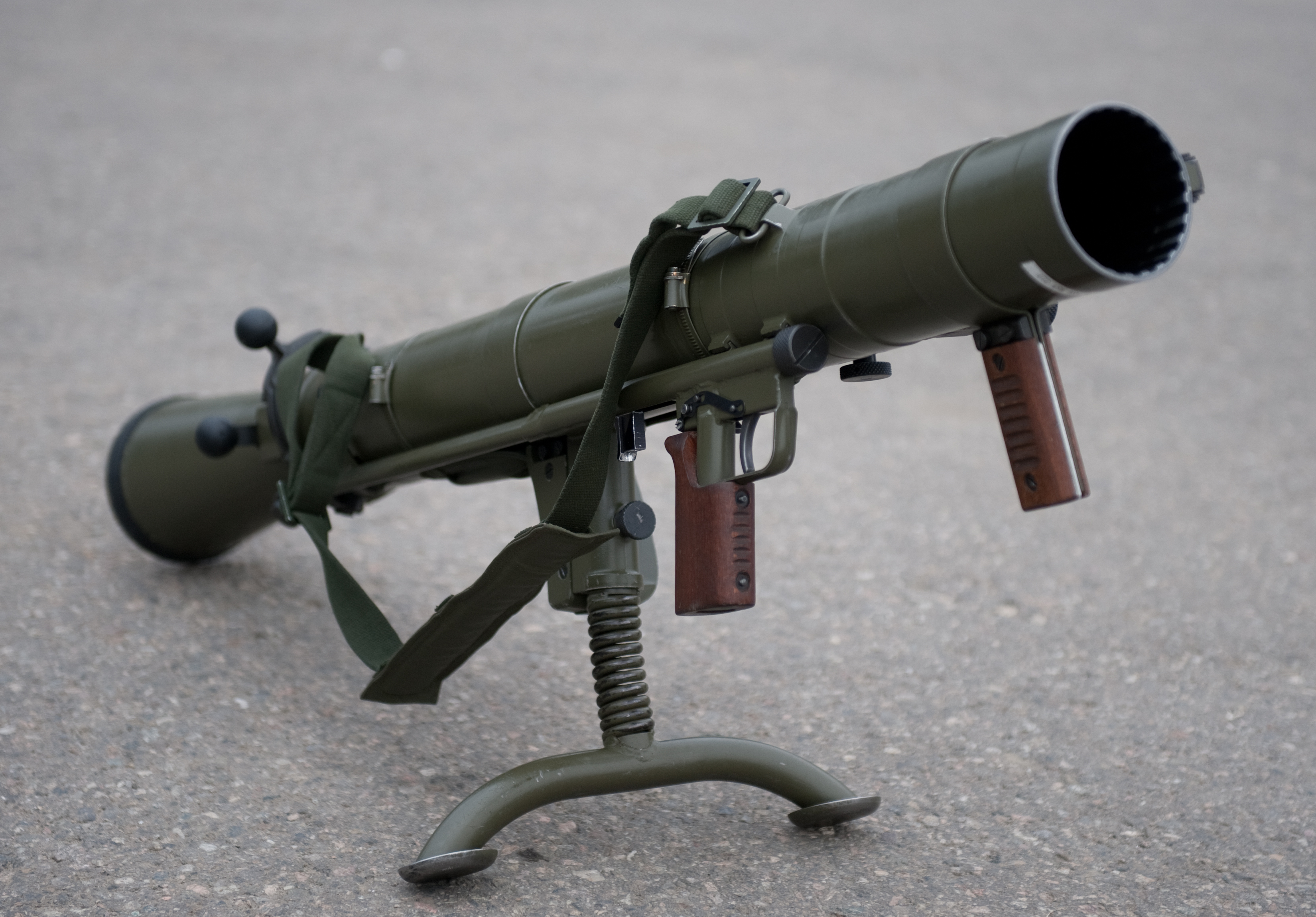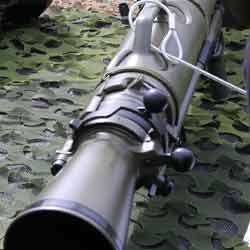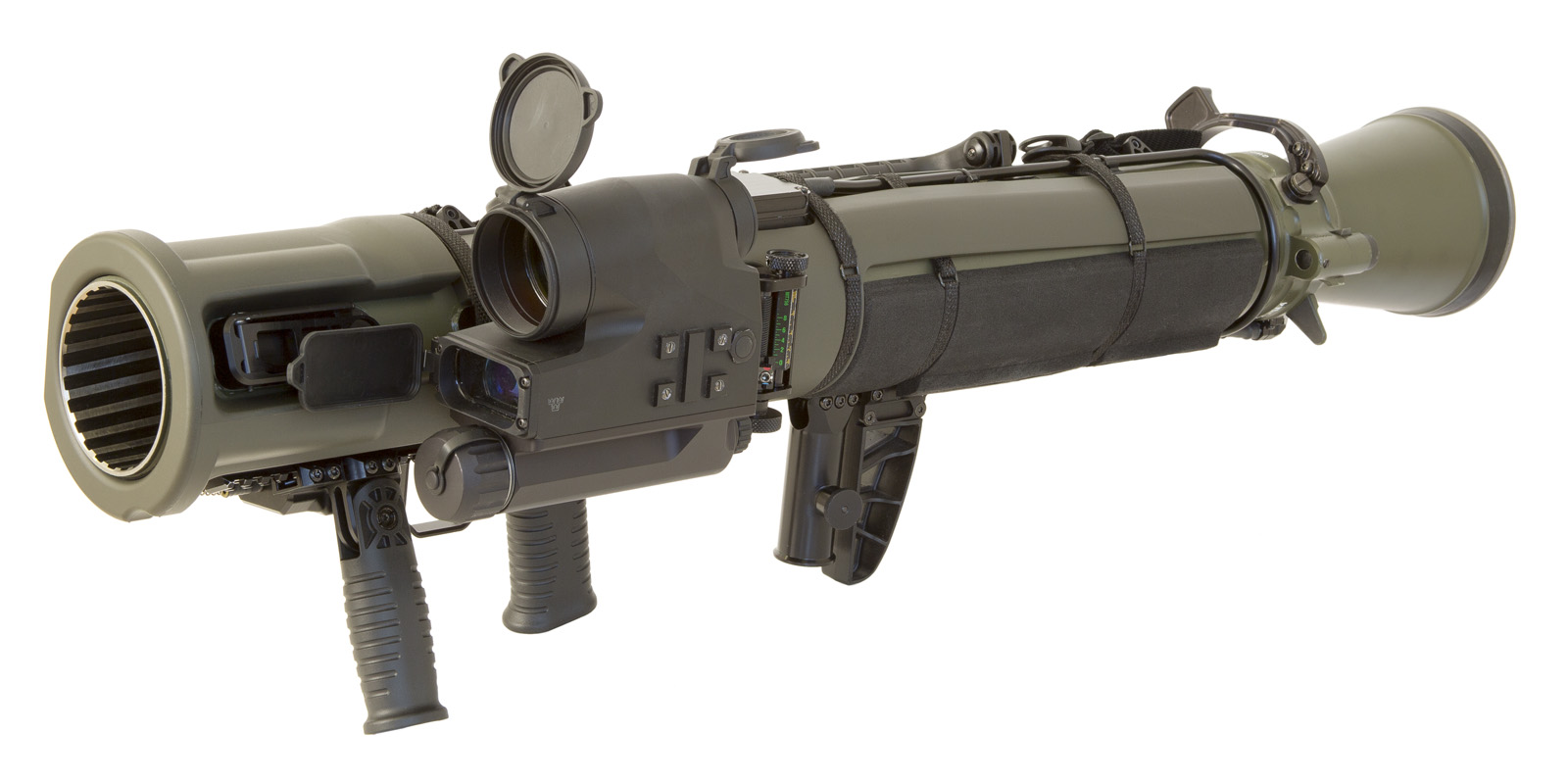Why the Carl-Gustaf® continues to enjoy success on the battlefield
The Carl-Gustaf® is known as the "slayer of Russian tanks in Ukraine." But what's behind its more than 80 years of longevity on the battlefield?
Anita Hawser & Peter Antill
20 October 2023

Man-portable shoulder-fired weapon systems, which date back to the Second World War, are enjoying somewhat of a renaissance on the modern-day battlefield thanks to their successes in Ukraine. One such system is the Carl Gustaf, which has earned the moniker, “The slayer of Russian tanks,” following claims from the Ukrainian Ministry of Defence (MoD) that the weapon system had destroyed two Russian T-90M main battle tanks (MBTs). One such video, shared on Twitter, claimed to show Kharkiv Territorial Defence fighters eliminating a T-90M “Breakthrough” tank near Stary Saltiv with a Carl Gustaf. “We thank the Swedish people and the King for their help,” the post read.
On the back of this, the British Army, which first adopted the Carl Gustaf towards the end of the 1960s in its M2 variant, as an infantry anti-tank capability (it was later replaced by the Light Anti-armour Weapon 80), started looking again at the weapon system. That interest soon materialised into an acquisition, with the UK’s Defence Equipment & Support placing a £4.6mn order with Saab in March this year for the delivery of Carl-Gustaf M4s, to replace the Anti-Structure Munitions the UK sent to support Ukraine against the Russian invasion.
Remarking on the acquisition, Major General James Bowder, the British Army’s Director of Futures, said, “The procurement of the Carl-Gustaf Mk4 will provide a versatile, potent, and proven capability to our close combat forces; it will defeat a range of threats on the modern battlefield, further enhancing our lethality.”
“The fact that the British Army is reintroducing the Carl-Gustaf into service after having phased it out once, is evidence of how well we have adapted the Carl-Gustaf system to the contemporary threat,” says Michael Höglund, head of the Ground Combat Dynamics business unit at Saab in Sweden. While Saab has had both NATO and non-NATO members as customers for its ground combat weapons, including the Carl-Gustaf, for decades, Höglund, told Defence Procurement International the war in Ukraine has made nations around the world look more into investing in their defence capabilities.
THE CARL-GUSTAF® M4
The last 12 months has seen a flurry of orders for the Carl-Gustaf and its “flexible” range of ammunition, which can handle a range of situations on the battlefield, whether it is destroying an armoured vehicle or structure, or illuminating the battlefield during night-time operations.
Outside of Sweden, one of the biggest and longest standing users of the Carl-Gustaf is the US, where the reloadable, multi-purpose system has been in service since 1990. In 2018, the US Army announced it would acquire the latest version of the weapon, the Carl-Gustaf M4 (designated M3A1 in the US). In May 2022, the US Army MAAWS Program Office awarded Saab a $16mn contract for Carl-Gustaf M4 recoilless rifles. The Carl-Gustaf rifles are known as the Multi-purpose Anti-Armor Anti-personnel Weapon System (MAAWS) and M3A1 in the US Army. The order includes deliveries of weapons for both the Army and the US Marine Corps.
“This order will make soldiers and Marines more agile thanks to the reduced weight and increased capability compared to the previous version currently in operational use,” said Erik Smith, President, and CEO of Saab in the US. “Additionally, it will increase interoperability across services, alliances, and partnerships, with so many already fielding the Carl-Gustaf M4.” The US Army started fielding M3 MAAWs weapon systems with regular units in Afghanistan in late 2012 as they were being engaged by RPGs out to 900 m, while their small arms and light support weapons had ranges of around 600 m. The M3 could airburst troops in defilade out to 1,250 m or use HE out to 1,300 m.
Interestingly, although US Special Operations Forces had used the M3 since the early 1990s, US Army light infantry unit commanders in Afghanistan had to submit operational needs statements to get the weapon. The M3 became an official “Program of Record” in the regular Army in 2014, and a conditional materiel release was authorised in late 2015 to equip all brigade combat teams with one M3 launcher per infantry platoon.
While the M3 had increased effectiveness, it's 9.5kg (21lbs) weight was a significant burden to troops carrying it. In March 2013, US Special Operations Command (SOCOM) issued a call for a kit to reduce both its weight and overall length, without compromising its ruggedness or performance. Thankfully, Saab had already started work on the M4 version, which had limited reductions in the expected barrel life, no increase in recoil and could fire a newly developed high explosive munition with a range of 1,500 m if fired using a fire control system.
Officially launched in 2014, the M4 weighed in at 6.6kg (15lbs) and had a length of 950 mm (37in). Not long after, Saab conducted a live-fire demonstration at the British Army's Close Combat Symposium at West Lavington on 20 July 2016.[iv] Since then, the M4 has been ordered by many different countries, entering service with the Swedish Army in 2018. Today, a total of 15 countries have acquired the M4. The latest country to procure the M4 is India, which has used the Carl Gustaf since 1976. Furthermore, Saab announced in September 2022 that it will be building a facility within India to produce the weapon system as well as export components to users around the world, the first such facility outside Sweden. According to Höglund, the Indian facility is progressing as planned and it aims to have production up and running by next year.
The US Department of Defense (DOD) completed testing the M4 in Autumn 2017 and it was designated the M3E1 MAAWS. The US Army then approved a requirement for 1,111 M3E1 weapon systems to be deployed using an Urgent Material Release (UMR) as part of the portfolio for the Product Manager, Crew Served Weapons (PE CSW) acquisition team. In November 2017, the US Marine Corps announced its intention to acquire 1,200 units, enough to equip one in each infantry squad, with deployment starting in mid-2021.[vi] The USMC is also considering acquiring it to replace the Mk. 153 SMAW (Shoulder-Launched Multi-Purpose Assault Weapon) in its combat engineer squads as it has a greater range of ammunition and an effective range of 1,000m, twice that of the SMAW.
THE CARL-GUSTAF® HAS ALWAYS BEEN USER FOCUSED
Two developments that will undoubtedly keep the weapon system up to date and generate export orders are a new programmable munition known as the HE 448 and a new Fire Control Device designated FCD 558. The two communicate using a protocol called Firebolt® to determine the best trajectory for the round. Both were showcased in a live fire event near Karlskoga, Sweden from May 3-4, 2022, which was attended by representatives from more than 30 countries.[vii]
By introducing the Firebolt communication the sighting system can get crucial information from the ammunition, such as ammunition type and ammunition temperature, explains Höglund. “This information, together with information from the sight such as ambient temperature and pressure is used to do a very accurate ballistic calculation. The user benefit is an improved probability of hit, less user input from the soldier (no need for manual adjustments/corrections) and faster engagement times. The communication interface is also used to programme rounds (in the barrel) with what we call the defeat mode, such as airburst and airburst distance.”
In July, Saab received an order from the Australian Department of Defence for the supply of additional Carl-Gustaf M4 weapons fitted with the new FCD 558. The Fire Control Device and the HE 448 high-explosive round were developed based on feedback from users. The round is designed for use against unprotected troops, troops in defilade, and soft-skin targets including vehicles. Saab Customer Service Representative Petter Grabbe said a common request among users was for a high-explosive round with a better ability to defeat body armour, which can reduce the effectiveness of fragmentation rounds. The 800 steel balls in the HE 441 round were replaced with 4,000 tungsten pellets in the HE 448, which increased the fragment density and the probability of striking vulnerable areas on enemy combatants. When combined with the FCD558, the HE round allows for the engagement of targets at much longer ranges.
“The development of Carl-Gustaf has always been user-focused, and developments and introductions of new capabilities are a result of listening to the customer and its needs,” says Höglund. “That’s probably the main reason for its continued success.”
As customer needs evolve, he says there is always room for further improvements. Yet, while some such as further weight reduction are always desired, he says Saab also needs to guarantee robustness and reliability. “We believe the Carl-Gustaf M4 offers a perfect combination between being lightweight and robustness.”
The war in Ukraine has also highlighted the need to safeguard forces against unmanned threats. Although there are no firm requests for the Carl-Gustaf to be used to defend against the threat posed by unmanned systems, Höglund says it is constantly monitoring what is happening in the unmanned domain, for both land and air. Saab is also working closely with suppliers of intelligent sighting systems for the M4. Currently, the Aimpoint FCS13 is qualified for the Carl-Gustaf and qualification is ongoing for the Senop AFCD Ti thermal imager and day sight.
“We continuously explore the sighting market for new and improved capabilities and take action if we see a benefit for the Carl-Gustaf system and the end user,” Höglund says. The company is also currently working on new ammunition capabilities for the Carl-Gustaf, spanning from improved anti-tank to multi-purpose including Confined Space variants. “We will continue to add capability to the Carl-Gustaf to keep one step ahead of the evolving threat,” says Höglund. “The Carl-Gustaf capability road map stretches well beyond 2030, so plenty of new capability will be made available for existing and new customers over the next decade.”
A History of the Carl Gustaf
The Carl Gustaf 84 mm man-portable, shoulder-fired, recoilless rifle was initially developed by Hugo Abramson and Harald Jentzen of the Royal Swedish Army Materiel Administration in 1946. It was based on an earlier model (the Carl Gustaf 20 mm recoilless rifle) and inspired by the success of man-portable anti-tank weapons in World War II such as the Panzerschreck and Bazooka.
Entering service in 1948, it received the designation 8.4 cm granatgevär m/48 with initial production being undertaken at the Carl Gustaf factory in Eskilstuna, which at the time was being run by the state agency Försvarets Fabriksverk (FFV). FFV continued to develop the weapon for both the domestic and international markets and was eventually merged into Saab Bofors Dynamics, who currently handles system development and export. The weapon system has enjoyed significant export success and service worldwide, right up to the present day.
Early variants of the Carl Gustaf include:
M1 – Fulfilling the same anti-tank role as the American Bazooka, German Panzerschreck and British PIAT, the main difference between these weapons and the Carl Gustaf is that the Carl Gustaf's barrel is rifled imparting spin to stabilise the round in flight, as opposed to the use of fins. Also, the use of a recoilless firing system allows Carl Gustaf's ammunition to hold considerably more propellant and achieve higher velocities (290 m/s compared to around 105 m/s for the Panzerschreck and Bazooka, and 75 m/s for the PIAT) resulting in better accuracy at increased range.

M2 – The M2 was introduced in 1964 as an improved, lighter, shorter version of the M1 for the export market, however, it quickly replaced the M1 across the globe. The M2 was in UK service from the late 1970s until the early 1990s as the L14A1 84mm Carl Gustaf Recoilless Rifle (aka the 'Charlie G'), which was replaced by the LAW 80.

M3 – Introduced into Swedish service in 1986, the M3 was even lighter, replacing the forged steel barrel with a thin metal tube (with the rifling), strengthened by a carbon fibre outer sleeve. The external parts were also replaced by plastic and aluminium components. The export version was introduced in 1991 and used in various roles (including anti-armour and bunker-busting) by many forces worldwide, including the British SAS.
M3 in US Service – In the late 1980s, the US Rangers (aka 75th Ranger Regiment) needed to replace their M67 Recoilless Rifles. A market survey by ARDEC in 1987 suggested that the M3 Carl Gustaf was the most suitable weapon to fulfil the Ranger Anti-Armour Weapon System (RAAWS) requirement and so it was selected in September 1988. A subsequent review of the manufacturer-supplied data suggested that the weapon did not meet US Army requirements, but fatigue tests done by Benét Laboratories showed that while the manufacturer's recommended life for the weapon was 500 rounds, the bores of two test weapons showed no sign of fatigue until 2,360 rounds. At this point the Navy Seals became interested in the weapon and the programme became a joint procurement, changing its name to the Multi-Role, Anti-Armour/Anti-Personnel Weapon System.
The Rangers found that the weapon was best employed by a two-man team with one soldier acting as the gunner and carrying the recoilless rifle, while the other acts as a spotter and carries additional rounds. The weapon system can fire a variety of rounds including high explosive (HE, 441/441B), high explosive anti-tank (HEAT/751), high explosive anti- tank rocket assisted projectile (HEAT-RAP/551) high explosive dual-purpose (HEDP/502), smoke (SMK/469) and anti-structure munition (ASM/509).
